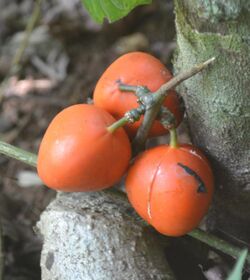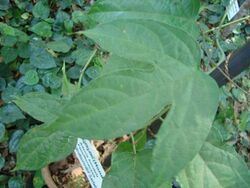Biology:Adenia hondala
| Adenia hondala | |
|---|---|

| |
| Fruits | |
| Scientific classification | |
| Kingdom: | Plantae |
| Clade: | Tracheophytes |
| Clade: | Angiosperms |
| Clade: | Eudicots |
| Clade: | Rosids |
| Order: | Malpighiales |
| Family: | Passifloraceae |
| Genus: | Adenia |
| Species: | A. hondala
|
| Binomial name | |
| Adenia hondala (Gaertn.) W.J.de Wilde, 1968)
| |
| Synonyms | |
| |
Adenia hondala, commonly known as hondala is a large, tuberous, woody climber which scrambles over other plants. It is found in the Indian subcontinent, including Sri Lanka, and in southeastern Asia. The tuber and the fruit are used as herbal remedies and the plant is used as a cure for snake bites. The caterpillars of several species of butterfly feed on this plant; these include the tawny coster, the clipper, the common cruiser and the Tamil lacewing.
Description
Adenia hondala is a climbing plant growing from a large irregular-shaped tuber. The woody, scrambling stems are thickened at the nodes. The leaves are alternate, with a tendril growing from each node, and these tendrils bear the flowers. The leaves are large and are deeply, palmately divided into three to five lobes; they have circular glands between the lobes. The flowers are greenish-white or bluish-white, each with a bell-shaped tube and five curled-back petals. The fruit is a capsule splitting into three valves with stiff rind and filled with seeds surrounded by fleshy white arils. The fruit is globular, green at first, turning orange as it ripens, and is poisonous. The fruits are poisonous and their resemblance to the fruits of the passion flower has led children to eat it mistakenly.[1][2][3]
Distribution
This plant is native to tropical southeastern Asia, Vietmam and the southwestern part of India and Sri Lanka.[2]
Ecology
The caterpillars of the tawny coster (Acraea terpsicore), the Tamil lacewing (Cethosia nietneri), the common cruiser (Vindula erota) and the clipper (Parthenos sylvia) feed on this plant.[4]
Uses
The young shoots and leaf stalks can be cooked and eaten. The tubers, which are poisonous, have antibacterial and antimicrobial properties and are used in Ayurvedic medicine for the treatment of skin disorders and to treat hernias. The seeds are used to combat the effects of poison, and the tubers are used to make a drug known as "vidari" or "vidaari", although this pharmaceutical is also made from other plants, Ipomoea mauritiana, Pueraria tuberosa and Cycas circinalis.[2] The plant is also used against snake bites.[1]
Status
Adenia hondala is a generally uncommon species. In Tamil Nadu its conservation status is listed as being near threatened while in Kerala and Karnataka it is listed as being vulnerable.[5]
References
- ↑ 1.0 1.1 "Hondala". Flowers of India. https://www.flowersofindia.net/catalog/slides/Hondala.html. Retrieved 8 October 2018.
- ↑ 2.0 2.1 2.2 Quattrocchi, Umberto (2016). CRC World Dictionary of Medicinal and Poisonous Plants: Common Names, Scientific Names, Eponyms, Synonyms, and Etymology (5 Volume Set). CRC Press. pp. 80–81. ISBN 978-1-4822-5064-0. https://books.google.com/books?id=-37OBQAAQBAJ&pg=PA80.
- ↑ "..Adenia hondala..". Efloraofindia. https://sites.google.com/site/efloraofindia/species/m---z/p/passifloraceae/adenia/adenia-hondala. Retrieved 22 November 2018.
- ↑ "Adenia hondala". Butterflies of India. http://www.ifoundbutterflies.org/larval-host-plants/742/Adenia-hondala. Retrieved 8 October 2018.
- ↑ "Plant Details for a Adenia hondala". Encyclopedia on Indian Medicinal Plants. ENVIS Centre on Medicinal Plants. http://envis.frlht.org/plantdetails/a01009173cb58a0acc3e74f682f95701/67afb98e32ac100959ca034d5f3b96e2. Retrieved 8 October 2018.
- Blumea; Tijdschrift voor de Systematiek en de Geografie der Planten (A Journal of Plant Taxonomy and Plant Geography). Leiden 15:265. 1968
- {{citation
| mode = cs1 | title = 449019 | work = Germplasm Resources Information Network (GRIN) | url = https://npgsweb.ars-grin.gov/gringlobal/taxonomydetail.aspx?449019 | publisher = [[Organization:Agricultural Research ServAgricultural Research Service (ARS), United States Department of Agriculture (USDA) | access-date = }}
Wikidata ☰ Q6009294 entry
 |


